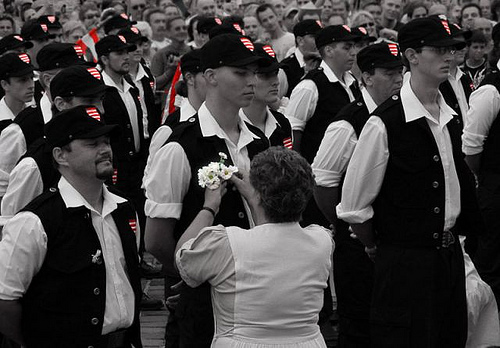The conflict between the Roma and the Hungarian community of Gyöngyöspata, a village north of Budapest, escalated drastically when paramilitary organizations appeared in the settlement some two weeks ago, after the far-right Hungarian political party's rally.
In February, a right-wing news site Barikád.hu published an article with a video (HUN) about Gyöngyöspata. The article was titled “Tzigane terror”–Heves county on the verge of civil war and reflected the problems of the village. Namely, the fear the Hungarian residents felt because of the crimes committed by members of the local Roma community. The reporters in the video told the majority inhabitants of Gyöngyöspata that “if it was needed, the [Hungarian] Guard would come and that would calm things down for a while.” To this statement the Hungarians nodded and said they would be grateful for that.
After the March 6 rally of the far-right party Jobbik, members of the new version of the banned Hungarian Guard arrived in the village. A group of betyárs, people who dress and act like the 18th-19th-century Hungarian “highwaymen,” appeared as well.
The far-right news site Kuruc.info had an artcile (HUN) on what this group of six “highwaymen” experienced in Gyöngyöspata:
[…] The betyárs reported that the Hungarians in Gyöngyöspata were happy because of the presence of the guardist neighborhood watch and the betyárs. Since their arrival, there's finally peace and calm in that part of the village where the Hungarians live. It's not like that on the gypsy side, where the 460 Roma are raging because they can't terrorize the elderly in the village, nor can they steal from them. […]
As the events unfolded, more and more journalists were travelling to Gyöngyöspata and publishing reports about the situation. Orsolya Fehér, a political analyst, quoted a Roma news site So Si? (HUN), which had Roma journalists reporting from the village:
[…] “We went to Gyöngyöspata on Thursday, March 10, and found we had to cross two checkpoints reminiscent of war movies to enter the Roma neighborhood,” wrote the www.sosinet.hu website. At that point, tension was intense between the Roma and the people clad in black uniforms surrounding them. “During our interviews, the local Roma residents told us about psychological terror and humiliation they were suffering, the constant fear they felt. It is not safe for them to leave their homes, even to go to work.” In their declaration, the local Roma drew attention to the fact that the members of the Hungarian Guard, hiding behind the Civil Guard Association for a Better Future and “gendarme” uniforms and openly supported by the Jobbik party, have kept the Roma residents of the village in a state of constant fear for the past two weeks. The situation has come to a point where the Roma are terrified to leave their houses, stopped sending their children to school and do not even feel secure inside their own homes. […]
Zupast of Mikor? Melyiket? blog commented the situation in a post titled Terror on the gypsy row [HUN]:
[…] This particular Neighborhood Watch Association for a Better Future is just named a ‘neighborhood watch’. The National Neighbourhood Watch Association, which has a code of ethics that prohibits discrimination on race and practice of party politics, distanced itself from the vigilantes of Gyöngyöspata. For Jobbik, it's not about a small settlement in Heves [county] but about the country-wide promotion coming with it. Simply, they needed a Roma pogrom to prove to those with the lowest intellect in the society that the beloved party wouldn't forsake them in clearing the air. […]
The Hungarian Civil Liberties Union (HCLU) together with the Hungarian Helsinki Committee and the Legal Defence Bureau for National and Ethnic Minorities (NEKI) sent a letter to the Minister of the Interior on March 13. In the meantime, on the basis of local investigations, HCLU took a legal position (.pdf) on the situation in the village:
The frightening act of the people arrogating the role of maintaining public order is not protected by freedom of assembly. With their threatening appearance, they questioned the absoluteness of state force-monopoly. The inactivity of the police caused legal uncertainty.
After the March 15 national holiday, members of the paramilitary organization left Gyöngyöspata, but the news about the alleged new targets were published right away.
Bloggers of Gyöngyöspata Solidarity wrote:
[…] As you know, the most recent news is that 3 towns are potential targets for the Gárda and these will probably be their next destinations: Hajdúhadház, Tiszavasvári, and Borsodnádasd.
The leading politician and MP of Jobbik, Gabor Vona, is said to be joining the civil guards(!) – potentially in Hajdúhadház. We are not sure where they are going first or when – they might go to more places at the same time. We must be on alert. […]
By Friday, news site [origo] reported (HUN) on the governmental meetings on paramilitary organizations and on the situation of Gyöngyöspata. The article stated there was no visible action taken in regards to the events in the village on behalf of the government – even though PM Viktor Orban and the Minister of the Interior had said several times earlier that they would not tolerate paramilitary organizations.








10 comments